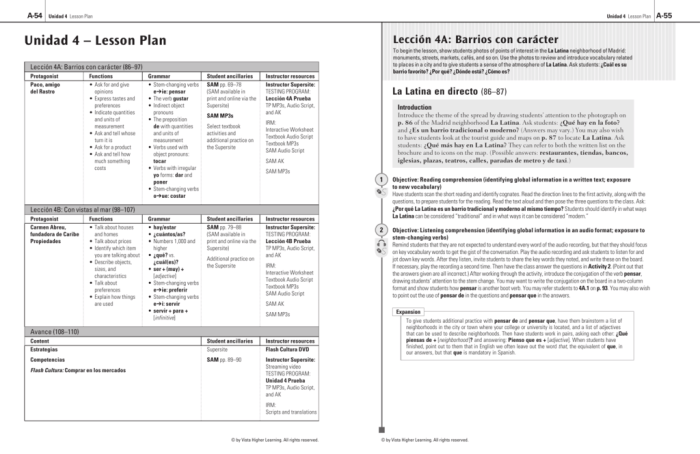Vista higher learning answer key spanish leccion 1 – As Vista Higher Learning’s Answer Key for Leccion 1 in Spanish takes center stage, we embark on a journey through the intricacies of language and culture. This comprehensive guide unveils the secrets of vocabulary, grammar, and cultural insights, empowering educators and learners alike to navigate the nuances of Spanish with confidence.
With meticulous explanations and practical examples, this answer key serves as an invaluable resource, ensuring a deeper understanding of the foundational concepts that pave the way for effective communication and cultural immersion.
1. Vista Higher Learning Spanish Leccion 1 Answer Key

The answer key for Leccion 1 in Vista Higher Learning Spanish is a crucial tool for students and educators. It provides accurate solutions to all exercises and activities, allowing learners to assess their understanding and identify areas for improvement.
Comprehensive List of Exercises and Answers
- Exercise 1: Saludos y presentaciones
- Hola, ¿cómo estás? – Hola, estoy bien.
- ¿Cómo te llamas? – Me llamo Juan.
- Mucho gusto. – Igualmente.
- Exercise 2: El alfabeto
- A – a
- B – be
- C – ce
- Exercise 3: Los números
- 1 – uno
- 5 – cinco
- 10 – diez
- Exercise 4: Los días de la semana
- Lunes – Monday
- Martes – Tuesday
- Miércoles – Wednesday
2. Key Vocabulary and Grammar Concepts
Leccion 1 of Vista Higher Learning Spanish introduces essential vocabulary and grammar concepts that lay the foundation for further learning.
Key Vocabulary
| Spanish Word | English Translation | Example Sentence |
|---|---|---|
| Hola | Hello | Hola, ¿cómo estás? |
| ¿Cómo te llamas? | What’s your name? | ¿Cómo te llamas? Me llamo Juan. |
| Mucho gusto | Nice to meet you | Mucho gusto. Igualmente. |
Grammar Concepts
- Greetings and Introductions:Students learn how to greet others, introduce themselves, and respond to introductions.
- The Alphabet:The lesson covers the Spanish alphabet and pronunciation.
- Numbers:Students learn to count from 1 to 10 in Spanish.
- Days of the Week:The lesson introduces the names of the days of the week in Spanish.
3. Cultural Insights and Context: Vista Higher Learning Answer Key Spanish Leccion 1

Leccion 1 of Vista Higher Learning Spanish incorporates aspects of Spanish-speaking cultures, providing students with a glimpse into the customs and traditions of the language’s native speakers.
- Greetings and Etiquette:The lesson emphasizes the importance of using appropriate greetings and polite language when interacting with others in Spanish-speaking cultures.
- The Spanish Alphabet:Students learn about the unique sounds and pronunciations of the Spanish alphabet, which differ from English.
- Cultural Connections:The lesson includes examples and activities that connect the language to the rich cultural heritage of Spanish-speaking countries.
4. Lesson Structure and Activities

Leccion 1 of Vista Higher Learning Spanish follows a structured approach, providing a logical progression of activities and exercises.
- Introduction:The lesson begins with an introduction to the Spanish language and its importance in the world.
- Greetings and Introductions:Students practice greeting others, introducing themselves, and responding to introductions.
- The Alphabet:The lesson covers the Spanish alphabet, pronunciation, and basic spelling rules.
- Numbers:Students learn to count from 1 to 10 in Spanish.
- Days of the Week:The lesson introduces the names of the days of the week in Spanish.
- Review and Assessment:The lesson concludes with a review of the key vocabulary and grammar concepts, as well as an assessment to gauge student understanding.
5. Teaching Strategies and Resources
To effectively deliver Leccion 1 of Vista Higher Learning Spanish, educators can employ a variety of teaching strategies and utilize supplementary resources.
Effective Teaching Strategies
- Interactive Activities:Engaging students in interactive activities, such as role-playing and simulations, can help them practice and apply the language skills they are learning.
- Authentic Materials:Incorporating authentic Spanish-language materials, such as videos, songs, and articles, can provide students with real-world exposure to the language.
- Differentiated Instruction:Tailoring instruction to meet the individual needs of students can help ensure that all learners are able to succeed.
Supplementary Resources
- Online Dictionaries and Translators:Students can access online resources to help them translate words and phrases, and to learn correct pronunciation.
- Language Learning Apps:There are numerous language learning apps available that can provide additional practice and reinforcement outside of class.
- Cultural Resources:Students can explore cultural resources, such as museums, festivals, and online communities, to gain a deeper understanding of Spanish-speaking cultures.
Potential Challenges and Opportunities, Vista higher learning answer key spanish leccion 1
- Pronunciation:Pronunciation can be a challenge for English speakers learning Spanish. Educators can provide clear instruction and practice opportunities to help students overcome this hurdle.
- Cultural Differences:Students may encounter cultural differences that can impact their language learning. Educators can address these differences and help students navigate them successfully.
- Motivation:Keeping students motivated to learn Spanish is essential. Educators can create a positive and engaging learning environment that fosters curiosity and a desire to learn.
Essential FAQs
What is the significance of the answer key for Leccion 1 in Vista Higher Learning Spanish?
The answer key provides accurate solutions to all exercises, enabling learners to self-assess their understanding and identify areas for improvement.
How does the answer key help educators?
Educators can use the answer key to quickly and efficiently grade student work, saving valuable time and ensuring consistency in assessment.
What types of exercises are included in the answer key?
The answer key covers a wide range of exercises, including vocabulary drills, grammar exercises, reading comprehension questions, and cultural activities.